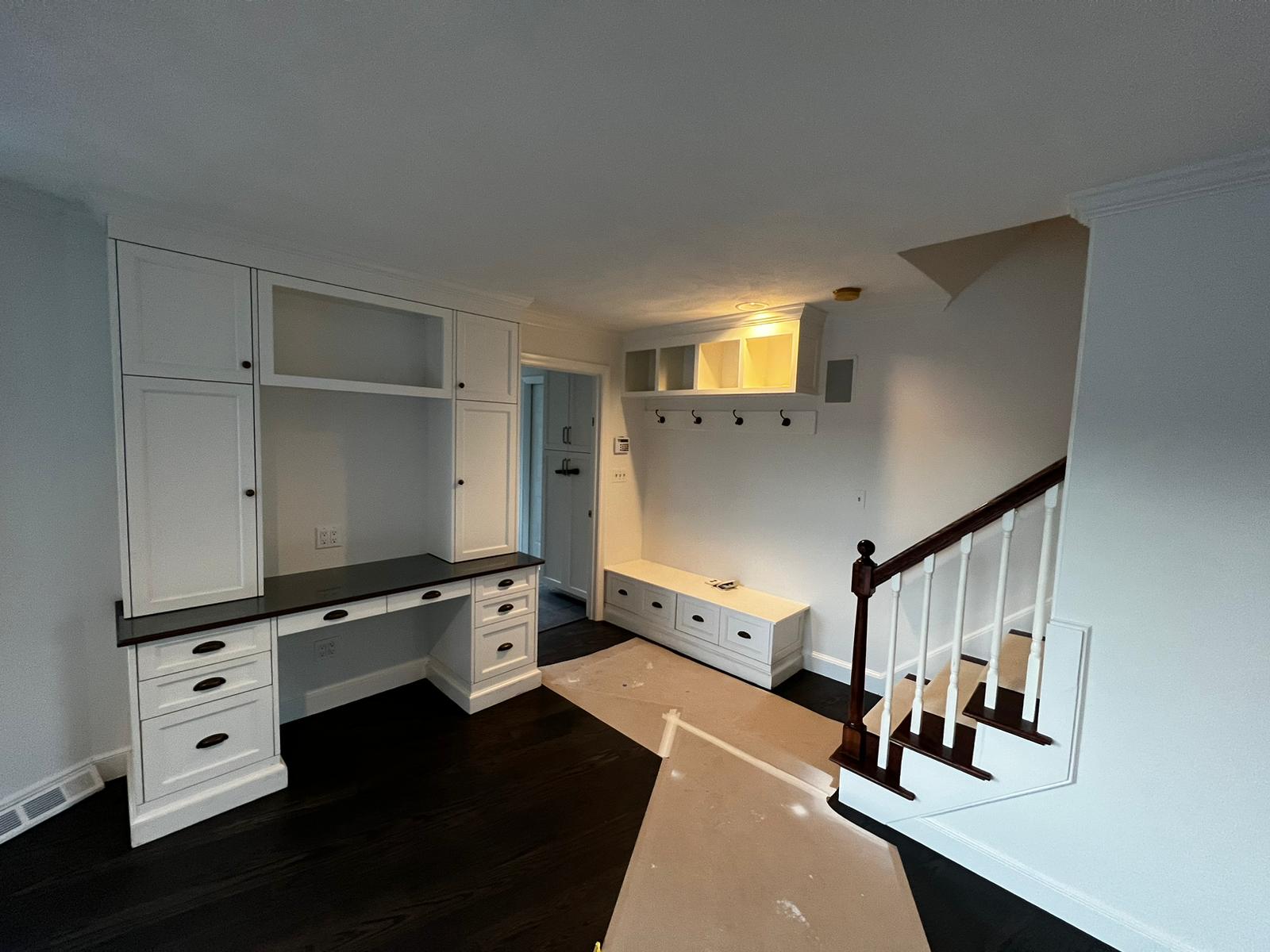Blogs

Ceiling vs Wall Paint | Key Differences & When to Use Each
When embarking on a painting project, it's common to encounter a bewildering array of paint options. Among the most frequent questions homeowners ask is whether there's a real difference between ceiling paint and wall paint. While they might both be acrylic latex, their formulations are distinct, tailored to the unique demands of their respective surfaces. Understanding these differences is crucial for achieving a professional-looking, long-lasting finish and avoiding common painting pitfalls.
Composition and thickness
The core differences between ceiling and wall paint begin at their fundamental composition.
Ceiling paint:
Composition: Typically formulated with a higher proportion of solids (pigments and fillers) and a lower proportion of binders (resins). This higher solid content contributes to its characteristic flat finish and excellent coverage, especially over imperfect surfaces.
Viscosity/Thickness: Ceiling paint is often a bit thicker than wall paint. This increased viscosity helps prevent drips and splatters, which is a major advantage when painting overhead. It also allows for a higher film build per coat.
Binder Flexibility: Binders are generally less flexible compared to wall paints, as ceilings don't experience the same expansion/contraction or direct contact.
Wall paint:
Composition: Contains a more balanced ratio of pigments, fillers, and binders. The binders in wall paint are typically more robust and flexible, designed to withstand frequent contact, cleaning, and minor impacts.
Viscosity/Thickness: Wall paint usually has a slightly thinner consistency than ceiling paint, which allows for easier rolling and brushing over large vertical surfaces, promoting a smoother finish.
Binder Flexibility: Binders are formulated to be quite flexible and durable, able to resist scuffs, marks, and repeated washing.
Coverage and finish characteristics
The physical properties of each paint type directly influence how they perform and look on their intended surfaces.
Ceiling Paint:
Coverage: Excellent hiding power due to its high solid content. It's designed to cover imperfections, previous colors, and stains (especially with a good primer) in fewer coats.
Finish: Almost exclusively comes in a flat (or dead flat) finish. This ultra-low sheen is its defining characteristic.
Washability: Generally has very low washability and scrubbability. Flat finishes are porous, making them prone to absorbing dirt and difficult to clean without leaving marks or rubbing off paint.
Light Reflection: A flat finish absorbs light, which helps to hide imperfections on a ceiling (which are often highlighted by light coming from windows).
Wall Paint:
Coverage: Varies by quality, but good wall paints offer excellent coverage. However, they might require more coats to cover stark color changes due to lower solid content compared to flat ceiling paint.
Finish: Available in a wide range of sheens, from flat/matte, eggshell, satin, semi-gloss, to high-gloss.
Washability: Varies significantly by sheen. Eggshell and satin finishes offer good washability and scrubbability, making them ideal for walls that need to be cleaned periodically. Higher sheens (semi-gloss, high-gloss) are the most durable and washable.
Light Reflection: Higher sheens reflect light, which can make rooms appear brighter but also highlight imperfections on the wall surface.
Why ceiling paint is flat (and why it matters)
The flat finish of ceiling paint is not a coincidence; it's a deliberate design choice that offers significant advantages for overhead surfaces.
Hides Imperfections: Ceilings are rarely perfectly smooth. They often have minor drywall imperfections, taping flaws, or hairline cracks. Light from windows and fixtures tends to graze across the ceiling surface, casting shadows that highlight any bumps, dips, or flaws. A flat finish absorbs light rather than reflecting it, effectively camouflaging these imperfections and creating a uniform, seamless look. Any sheen on a ceiling would act like a spotlight on every flaw.
Minimizes Glare: A flat finish prevents glare, which can be distracting, especially from overhead lighting or sunlight streaming through windows.
Prevents Flashing: Flat paint helps prevent "flashing," which occurs when variations in paint application (e.g., roller marks, brush strokes, touch-ups) dry to different sheens, making them visible. The uniform light absorption of flat paint minimizes this effect.
Non-Reflective Background: It provides a neutral, non-distracting background for the room, allowing the walls, furniture, and décor to be the focal point.
Easier Touch-Ups (in terms of sheen): While not easily washable, touch-ups on a flat ceiling are often less noticeable in terms of sheen variation compared to trying to touch up a wall with a higher sheen.
Can you swap one for the other?
While technically possible to apply one type of paint to the other surface, it's strongly not recommended for optimal performance and appearance.
Using ceiling paint on walls:
Pros: Can provide good coverage, especially for quickly covering a dark color.
Cons:
Poor Durability: It's not designed for contact. It will scuff very easily.
Difficult to Clean: Any attempt to wipe marks or dirt will likely leave noticeable streaks, marks, or even remove the paint.
Appearance: The ultra-flat finish might feel dull or dead on a vertical wall, and it won't stand up to the wear walls experience.
Using wall paint on ceilings:
Pros: If you have leftover wall paint and are doing a quick touch-up of a small, unnoticeable ceiling spot, it might be "possible" in a pinch.
Cons:
Highlights Imperfections: Any sheen (eggshell, satin, semi-gloss) will reflect light and mercilessly highlight every imperfection, bump, or roller mark on the ceiling.
Drips and Splatters: Wall paint is thinner and more prone to dripping and splattering when applied overhead, making for a messier and more frustrating job.
Coverage Issues: Might require more coats to achieve full hiding, especially if it's a lighter consistency or a paint with less solid content.
In summary, using ceiling paint on walls results in a fragile, unmaintainable finish. Using wall paint on ceilings results in an aesthetically flawed and messy job.
Choosing the right paint for each surface
To ensure a successful and durable paint job, always select paints specifically designed for their intended surface.
For Ceilings:
Product Type: Look for paint explicitly labeled "Ceiling Paint."
Sheen: Always choose flat or dead flat.
Color: White is traditional, but tinted ceiling paints are available for a softer look or to complement wall colors subtly.
Features: Look for "non-drip" formulas and good hiding power. Some come with a color indicator that turns white as it dries to help ensure even coverage.
For Walls:
Product Type: Look for paint labeled "Interior Wall Paint" or "Interior Latex Paint."
Sheen: Choose based on the room's function and desired durability:
Flat/Matte: Best for low-traffic areas (e.g., formal living rooms, bedrooms), hides imperfections well, sophisticated look.
Eggshell: A very popular all-around choice. Slightly more durable and washable than flat, with a subtle sheen. Good for bedrooms, living rooms, hallways.
Satin: A bit more sheen than eggshell, very durable and washable. Ideal for high-traffic areas, kitchens, bathrooms, kids' rooms.
Semi-Gloss/High-Gloss: Best for trim (doors, baseboards, window frames), highly durable, very washable, and highlights architectural details. Less common for full walls, but can be used for a bold, modern, or retro look in specific areas.
Features: Consider low-VOC options for better indoor air quality. Some paints offer enhanced scrubbability or stain resistance.
By understanding these fundamental differences and making informed choices, you'll ensure your painting project yields beautiful, long-lasting results that enhance your home's interior for years to come.
Ready to achieve a flawless finish on every surface of your home? Contact Masterpiece Painter today for expert advice and a professional painting service that understands the nuances of every paint type!
About Masterpiece Painter
For over 17 years Masterpiece Painter, has been serving communities all around New England. Let us help you make your wishes come true by turning your property into a Masterpiece
Get a Quote

© copyright 2023 All Rights Reserved.



